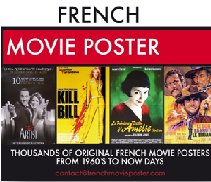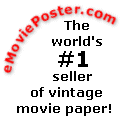The still is one of the least
expensive and most common AND most misunderstood collectible in our hobby.
Collectors primarily look at the still as just a small piece of the presskit
and therefore insignificant. We wanted to follow the still through the film
making process to show just how important the still actually is.
There are a great many steps in getting a film started
into production. Let's start with a script that has been green-lighted and
a team has been put together consisting of a small growing army that will
start putting together the behind the scenes functions. While the director
assembles his staff and the producer creates the budgets for each department,
a tremendous amount of decisions have to made from shooting locations, cast
members, storyboarding, shooting crew and costuming, etc.
OK... "what does this have to do with the still?"..
you might ask.
You basically have 2 different filming processes going
on at the same time during the shooting of the film. While the motion picture
camera man is shooting the actual film, a photographer is also capturing all
of the scenes with a still camera.
At the end of the day, the negatives of these 2 processes
go to processing and editing but in completely different directions. While
the movie film goes to it's processing for the editing of the film, the stills
are processed and sent in a different direction.
Again the 'WHY?'..... well, stills taken by a photographer
on set are a lot easier to use than the actual movie film. These stills give
the publicity department clearer glimpses that could then be used in a wide
variety of ways....... plus the publicity department wouldn't have to wait
on the editing department of the movie film to finish before the publicity
department can have the material that they would need. While the movie film
process is also interesting, we want to follow the processing of the stills.
To understand the process let's back up and start
with the duties of the unit photographer and then the additional photographers.
UNIT PHOTOGRAPHER
The images taken by the unit photographer or overflow photographers
were developed daily and distributed to various departments for specific purposes.
These include the following:
• Pre-Production
• Production
• Scene Continuity
• Publicity
* Key Set Creation
* Exclusive Uses
* Advertising
* Creation of Posters
* Creation of Lobby Cards
* Press Use – Studio/National Screen Service
* New York Newspaper Set
• Special Uses
Pre-Production
The first stills taken on a film were normally done before filming
actually began and part of the initial planning and development. Sample costumes
were made and the main cast members were normally sent to photo sessions in
these costumes. These photo stills were used in a variety of ways from administrative
planning, storyboarding, budget and production meetings and sometimes being
sent to artists to start conceptual artwork for advance publicity.
Production
Once filming began on the project, the unit photographer had several
jobs. One of the jobs that is normally overlooked was keeping track of the
production SETS. At the end of that day’s shooting, the photographer
took photos of all of the movie’s sets.
Scene Continuity – In addition
to their use for publicity and advertising purposes, the still photographs
which were taken at the end of a day’s film shoot were used by the
director and his staff to ensure continuity of scenes for the next day’s
shooting. These photos allowed the crew to compare the sets from the prior
day’s shooting to make sure that it was consistent.
During the production the unit photographer was responsible for capturing
thousands of still shots while the movie cameras were running. Some of the
photos would offer a different angle to the motion picture camera. In other
cases, the photographer would stand next to a movie camera operator. And some
of the shots would be behind the scenes with actors and directors.
After the final production still shots were taken each day, the roles
of film negatives were placed on contact sheets (created by laying the negatives
on a piece of printing paper and exposing them to light to create a set of
mini prints the same as the film frames) (IMAGE) The contact sheets were then
forwarded to the publicity department. The Publicity Department could then
view the full roll of 36 images at one time with a “ring” or magnifying
glass.
Publicity Department –The Publicity
Department was, among other things, responsible for generating early publicity
about a film, including providing information to magazines and publications.
In addition, they were responsible for providing the Advertising Department
with information necessary to create the film’s promotional materials.
The publicity department would review the contact sheets and select images
for specific purposes, such as creating a key set, keeping track and providing
exclusive images to magazines and publications, and sending the advertising
department information necessary to begin preparation of promotional materials.
Key Set Creation - After a review
by the publicity department, the better images were picked to become part
of a key set. The selected images are numbered by placing an assigned number
by the studio for that particular film, called the production number, and
then a dash and the assigned individual still number. THIS is called the
Production Code number. For more on this, see our artilce on Production
Stills Numbers.
The selected stills were then printed and placed into the key set
binder. The rejects are skipped over and left unnumbered. The negatives
and contact sheets were then filed. These may be pulled at a later date
when someone wants something different.
By the end of the shooting, this 'key set' would normally be hundreds
of the better still shots to be used in a variety of ways by the publicity
department. The stills used in this 'key set' would have numbers put on
the still to help the publicity department identify and keep up with the
different stills. They were kept in large bound books that could be used
at any time for reference.
Exclusive Use –
Major magazines and publications would quite often want exclusive photos
to do an article on the upcoming film. This was a tremendous way for the
film to get FREE publicity. To accommodate them, the publicity department
would put a hold on numerous stills and send over a group for the editor
to choose from. Once the exclusives were picked, the tags would be removed
from those images not selected so they could be used for other purposes
As a side note: (just to add in a little confusion) SOMETIMES….
For larger and favored publications, the publicity department would choose
certain images and enlarge them to 10x13” or 11x14”. These larger
shots gave the image a more portrait appearance and would quite often win
more publicity space.
Advertising Department – The
advertising department was responsible for developing and initiating the
advertising budget to be used for promoting the film. Once the budget was
established, the advertising department would line out their complete advertising
campaign. The black & white and color stills provided by the publicity
department would be used in a number of ways, including the following:
Creation of Posters – The advertising
department would select certain stills and provide them, along with a synopsis
of the film, to the art department. It was the art department’s responsibility
to design and complete the poster art, either using in-house staff or contracting
with a commercial artist.
Creation of Lobby Cards – The
art department would also utilize the color stills provided by the publicity
department to make lobby cards.
Creation of Advertising Clips –
The advertising department would use both stills and artwork provided by
the art department to create the ads that were to be used by the theater
managers to promote the film locally.
In the silent and early ‘talkie’ years, this artwork
would be sent to contracted companies to produce the ads on wood blocks
that could be ordered by the theater and sent to the local newpapers for
publication. This was replaced by the lighter plates and then eventually
by Ad Supplements that had clip art that the theater could send to the newspaper.
Press –
Prior to National Screen,
the advertising department would offer sets of stills to individual theaters
for their use in advertising a specific film. When National Screen Service
took over the distribution of movie paper for the major studios, the NSS
would offer press stills to theaters and exhibitors along with the other
sizes of movie posters and all types of promotional materials. Beginning
in the 1970’s, press stills became part of the press kits that were
distributed by NSS.
New York Newspaper Set
– Starting in the 1960’s, the advertising department
would provide a basic pack of stills, referred to as The New York Newspaper
Set, to wire services and newspapers around the country. This set included
30-40 stills selected from the key set.
COLOR PHOTOGRAPHER
In earlier days and on smaller productions, the color photographer
was also the unit photographer. But for larger productions, it was very common
for a second photographer to be used on the set just to produce the color
stills. This really increases in the 1960s when magazines and major publications
started demanding more color.
These stills were handled exactly the same as the standard black
and white stills EXCEPT that they were a separate operation. In other words,
different personnel handled the color and it had very little to do with the
regular stills operation.
The rolls were sent on contact sheets and chosen the same way. The
color desk also sent over the selection to the advertising department that
was going to be used to make the lobby cards.
SPECIAL PHOTOGRAPHER
For certain circumstances, such as blockbusters or some major films,
specially contracted photographers were used. This would normally be a certain
photographer that one of the stars happened to like that would requested to
come make special promotional shots. These photographers would be allowed
on the set for major scenes or at the end of the days shooting where the star
would recreate a certain scene or pose for publicity purposes.
Sometimes it might be a publication that was going to do a major
feature on the upcoming film that would send down their own special photographer.
In these instances, the photographer would own the copyrights to
the shots under certain circumstances with the understanding the if there
were any shots that the studio wanted, the special photographer would release
them to the studio.
From time to time, the studio would request the usage of one or more
of the special photographer’s images. These images would then be incorporated
into the key set or other press materials, with the permission of the special
photographer.
For more on identifying the different types of production code stills,
see our article on Identifying
Production Stills.
Stills
You must be logged
in to see these articles
Not a member? see
here for more info
Introduction
to Production Logs
US Movie Studio Production Logs:
20th
Century Fox - Letters - 20th
Century Fox - Numbers
AIP
Columbia
Fox
Pictures - Letters - Fox
Pictures - Numbers
Goldwyn Picture - see MGM
Grand
National
Metro Goldwyn - see MGM
MGM
Shorts - Letters - MGM
Shorts - Numbers - MGM
Numbers
Monogram
- Letters - Monogram
- Numbers (includes Allied Artists)
Paramount
- Letters - Paramount
- Numbers
PRC
Republic
RKO
- Letters - RKO
- Numbers
Universal
- Letters - Universal
- Numbers
Warner
Bros. - Letters - Warner
Bros. - Numbers
A special thanks to Rudy Franchi for his help and
knowledge in this area.





